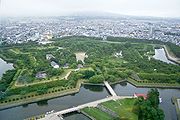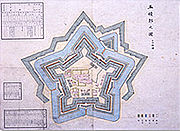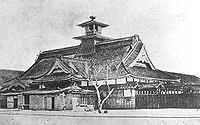
Goryokaku
Encyclopedia



Star fort
A star fort, or trace italienne, is a fortification in the style that evolved during the age of gunpowder, when cannon came to dominate the battlefield, and was first seen in the mid-15th century in Italy....
in the city of Hakodate
Hakodate, Hokkaido
is a city and port located in Oshima Subprefecture, Hokkaido, Japan. It is the capital city of Oshima Subprefecture.Hakodate was Japan's first city whose port was opened to foreign trade in 1854 as a result of Convention of Kanagawa, and used to be the most important port in northern Japan...
in southern Hokkaidō
Hokkaido
, formerly known as Ezo, Yezo, Yeso, or Yesso, is Japan's second largest island; it is also the largest and northernmost of Japan's 47 prefectural-level subdivisions. The Tsugaru Strait separates Hokkaido from Honshu, although the two islands are connected by the underwater railway Seikan Tunnel...
, Japan
Japan
Japan is an island nation in East Asia. Located in the Pacific Ocean, it lies to the east of the Sea of Japan, China, North Korea, South Korea and Russia, stretching from the Sea of Okhotsk in the north to the East China Sea and Taiwan in the south...
. It was the main fortress of the short-lived Republic of Ezo
Republic of Ezo
The ' was a short-lived state established by former Tokugawa retainers in what is now known as Hokkaidō, the large but sparsely populated northernmost island in modern Japan.-Background:...
.
History
Built by the Tokugawa shogunateTokugawa shogunate
The Tokugawa shogunate, also known as the and the , was a feudal regime of Japan established by Tokugawa Ieyasu and ruled by the shoguns of the Tokugawa family. This period is known as the Edo period and gets its name from the capital city, Edo, which is now called Tokyo, after the name was...
in 1857-1866, it was located in the center of the port of Hakodate, on the island of Hokkaidō
Hokkaido
, formerly known as Ezo, Yezo, Yeso, or Yesso, is Japan's second largest island; it is also the largest and northernmost of Japan's 47 prefectural-level subdivisions. The Tsugaru Strait separates Hokkaido from Honshu, although the two islands are connected by the underwater railway Seikan Tunnel...
. Shaped like a five-pointed star, it allowed for greater numbers of gun emplacements on its walls than a traditional Japanese fortress, and reduced the number of "blind spots" where a cannon could not fire. In designing Goryokaku, Takeda Ayasaburō
Takeda Ayasaburo
, was a Japanese Rangaku scholar, and the architect of the fortress of Goryōkaku in Hokkaidō.Takeda was born in the Ōzu Domain in 1827. He studied medicine, Western sciences , navigation, military architecture. He was a student of Ogata Kōan and Sakuma Shōzan...
, a Rangaku
Rangaku
Rangaku is a body of knowledge developed by Japan through its contacts with the Dutch enclave of Dejima, which allowed Japan to keep abreast of Western technology and medicine in the period when the country was closed to foreigners, 1641–1853, because of the Tokugawa shogunate’s policy of national...
scholar, adopted elements of the designs of the French architect Vauban
Vauban
Sébastien Le Prestre, Seigneur de Vauban and later Marquis de Vauban , commonly referred to as Vauban, was a Marshal of France and the foremost military engineer of his age, famed for his skill in both designing fortifications and breaking through them...
, who developed fortresses responding to the spread of the use of cannon
Cannon
A cannon is any piece of artillery that uses gunpowder or other usually explosive-based propellents to launch a projectile. Cannon vary in caliber, range, mobility, rate of fire, angle of fire, and firepower; different forms of cannon combine and balance these attributes in varying degrees,...
in war
War
War is a state of organized, armed, and often prolonged conflict carried on between states, nations, or other parties typified by extreme aggression, social disruption, and usually high mortality. War should be understood as an actual, intentional and widespread armed conflict between political...
fare.
Goryōkaku is famous as the site of the last battle of the Boshin War
Boshin War
The was a civil war in Japan, fought from 1868 to 1869 between forces of the ruling Tokugawa shogunate and those seeking to return political power to the imperial court....
. On December 9 (lunar calendar
Lunar calendar
A lunar calendar is a calendar that is based on cycles of the lunar phase. A common purely lunar calendar is the Islamic calendar or Hijri calendar. A feature of the Islamic calendar is that a year is always 12 months, so the months are not linked with the seasons and drift each solar year by 11 to...
October 26), 1868, Ōtori Keisuke and Hijikata Toshizo
Hijikata Toshizo
was the vice-commander of Shinsengumi, a great swordsman and a talented Japanese military leader who resisted the Meiji Restoration.-Background:...
and their troops entered the fort. A week after Hijikata's death, on June 27 (lunar calendar May 18), 1869, Goryokaku fell to the new army of Japan
Imperial Japanese Army
-Foundation:During the Meiji Restoration, the military forces loyal to the Emperor were samurai drawn primarily from the loyalist feudal domains of Satsuma and Chōshū...
, and much of it was reduced to ruin.
Today, Goryōkaku is a park. It has been declared a Special Historical Site and is home to the Hakodate city museum. The grounds are a favorite spot for hanami
Hanami
is the Japanese traditional custom of enjoying the beauty of flowers, "flower" in this case almost always meaning cherry blossoms or ume blossoms. From the end of March to early May, sakura bloom all over Japan, and around the first of February on the island of Okinawa...
.
See also
- List of Special Places of Scenic Beauty, Special Historic Sites and Special Natural Monuments
- Benten DaibaBenten Daibawas a key fortress of the Republic of Ezo in 1868-1869. It was located at the entrance of the bay of Hakodate, in the northern island of Hokkaidō, Japan....
, another key fortress of the Republic of Ezo.

